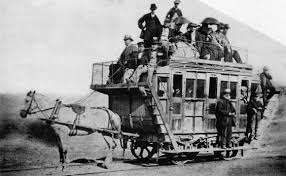From moving trains and lighting carriages to making sure we can charge our phones, the railways need power!
But the kind of power used by the railways has changed over the years.. Bex and Dan find out more in our podcast series!
The very earliest trains were gravity powered or pulled by horses; in fact, the very first train line in the UK was called the Swansea and Mumbles railway.
As you can imagine – this meant they didn’t go very fast…

As more trains were built, and more people wanted to use them, trains were pulled by locomotives powered by steam – engines that burn fuel in fireboxes, creating smoke that rises through chimneys at the front.
The heat in the firebox boils water to produce steam, which is fed into cylinders where it expands to drive the pistons. The movement of the pistons turns the wheels with the help of a rod and a crank, which moves the train.

The trouble with steam is that it takes a long time to get ready – several hours at the start of the day to build up a fire and several more at the end of the day to clean out the fire boxes. Steam trains also need to carry around a lot of coal and water – that’s weight that slows down the trains.
Diesel is another kind of fuel that has powered trains since the 1950s. Diesel trains are easier to maintain.
For a start, you don’t need someone to tend the fire, just turn the key and you’re off. They’re an improvement over steam but not without their own problems.
Diesel trains still have to carry their own fuel, which is heavy and takes up valuable space. Diesel is also dirty, like coal, and can be quiet noisy!

Now, new trains are being built, like electric ones!
Electric trains get their power from an overhead contact wire which hang down from catenaries. The contact wires is zig-zagged slightly to the left and right so that the pantograph wears evenly.
They are faster than diesel and can accelerate more quickly, helping create more space for other trains. They are also quieter which is good news for people who live near the railway.
Plus, because you don’t need large engines or to carry fuel around, you can fit more seats in an electric train compared to a diesel train of the same length. If that all wasn’t enough – they’re also lighter causing less wear to the track, and require less maintenance.
Overall, they’re better for the environment!

Today, about 40% of Britain’s railway network is electrified. Some lines are currently being electrified, and there are plans to electrify more lines across the country.
Overhead lines aren’t the only way to power electric trains. Sometimes electricity is supplied through rails underneath the train Whilst cheaper to build than overhead lines, these rails suffers more in winter when they can be covered by snow and ice causing trains to lose power.
Find out more about Britain’s railways!
Bex and Dan from Fun Kids learn all about the future of Britain’s railways, from signals to trains and tracks, in this new podcast series!



 Apple Podcasts
Apple Podcasts Google Podcasts
Google Podcasts